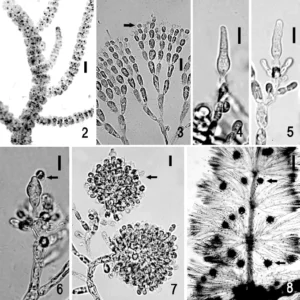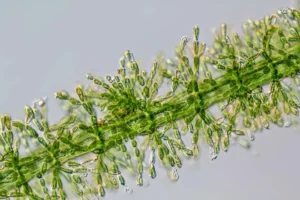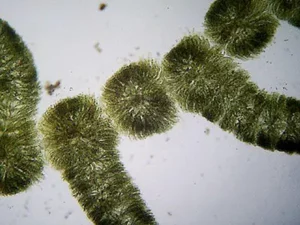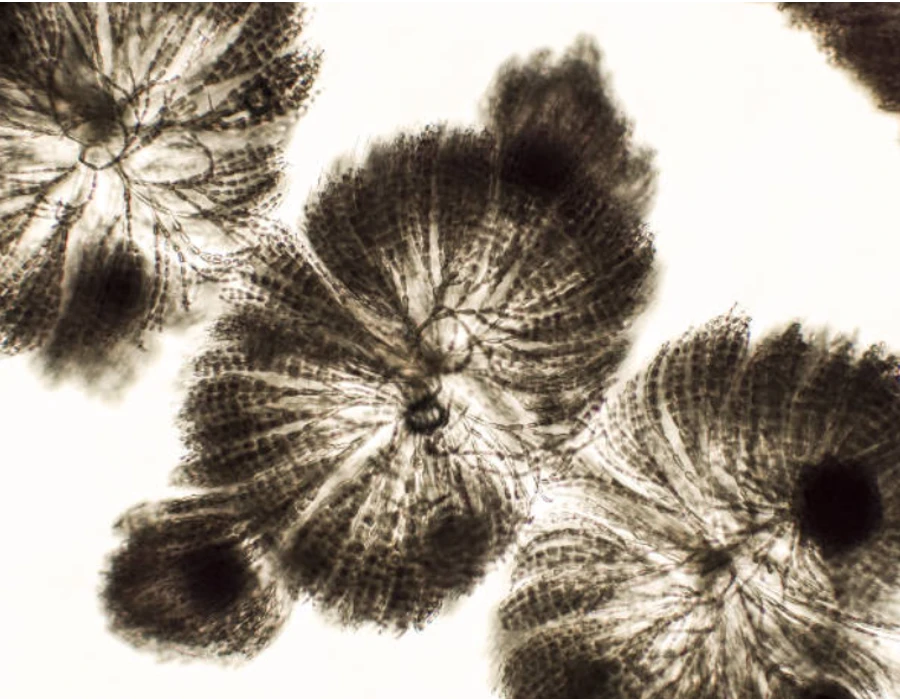Contents
CLASSIFICATION OF BATRACHOSPERMUM
Sub-division :- Algae
Class :- Rhodophyceae
Sub-class :- Florideae
Order :- Nemalionales
Family :- Batrachospermaceae
Genus :- Batrachospermum
Batrachospermum is commonly found in fresh waters. The filaments are attached to stones in slow moving waters of rivers and streams or on the margins of the lakes.
EXTERNAL FEATURES OF THALLUS OF BATRACHOSPERMUM
- Thallus is multicellular and filamentous. Filaments are branched.
- Adult thallus appears as a chain of beads. It is mucilaginous and violet or blue in colour.
- Thallus remains attached to the substratum by old shoots which form a prostrate system.
- The main axis (primary axis) is corticated. It is differentiated into nodes and internodes. Branches are borne at the nodes.
- Two types of branches occur-(i) branches of unlimited growth and (ii) branches of limited growth.
- Primary axis and branches of unlimited growth arise from nodes. These show monopodial or pseudo-dichotomous branching.
- Long branches or branches of unlimited growth are differentiated into small nodes and long internodes.
- Primary axes and branches of unlimited growth are enveloped by several layered cortex.
- Dwarf branches or branches of limited growth arise laterally in whorls from the nodes of primary axes. (Clusters thus formed give beaded appearances to the thallus).
- Each cluster formed at the node, is called a glomerule.
- The laterals consist of small, ellipsoidal or moniliform and uninucleate cells.
- Among these lateral branches are situated large clusters of carpospores.

Reproductive structures of BATRACHOSPERMUM
- The species are monoecious and male and female sex organs occur near the apex.
- Male sex organs are antheridia. These are present in clusters on short branches of lateral filaments.
- Antheridia are oblong or spherical and unicellular.
- Each antheridium produces a single, spherical, colourless, naked, uninucleate and non-motile spermatium.
- Female sex organs are carpogonia situated at the apex of 3-4 celled lateral carpogonial branch.
- Carpogonium is made of a basal swollen portion with a terminal, elongated, tubular process called trichogyne.
- As a result of fertilization cystocarp is formed. This appears as a cluster of carpospores in glomerules.
- Cystocarp remains covered by sterile branches.
- Inside the cystocarp lie many branched gonimoblast filaments.
- The terminal swollen cells of these filaments are carposporangia. Each carposporangium produces a single carpospore.

IDENTIFICATION OF SARGASSUM
- Sub-division– Algae
- Presence of a simple thallus.
- Chlorophyll present
- Cell wall made of cellulose.
- Class– Rhodophyceae
- Chromatophores pure red to dark purple.
- Photosynthetic reserve-floridean starch and floridoside.
- Male gametes non-motile.
- Female reproductive organ with trichogyne-a receptive structure.
- Post-ferilization product a cystocarp.
- Sub-class :- FIorideae
- Thallus basically filamentous.
- Pit connections between sister cells.
- Cells with more than one chromatophore.
- Carpogonium highly specialised.
- Order– Nemalionales
- Plants filamentous, corticated, unior multiaxial.
- Cells uninucleate, chromatophores axial or lateral.
- Cystocarps superficial or deeply embedded in the thallus.
- Life cycle without free-living tetrasporophyte.
- Family – Batrachospermaceae
- Inhabit freshwater.
- Thallus uniaxial.
- Life cycle haplobiontic.
- Genus – Batrachospermum
- Main axis and branches free from one another.
- Branching appears beaded.
- Threads embedded in large amount of mucilage.



Leave a Reply